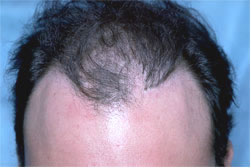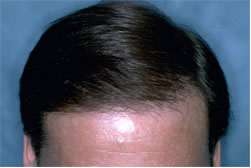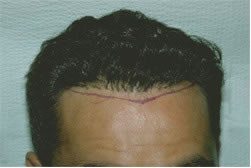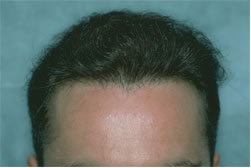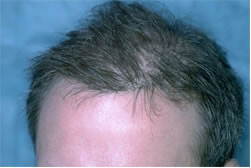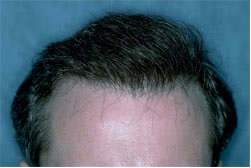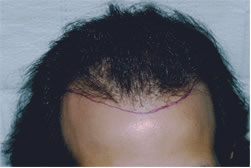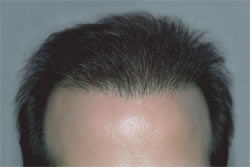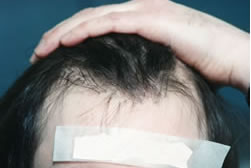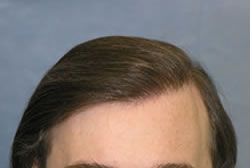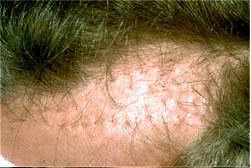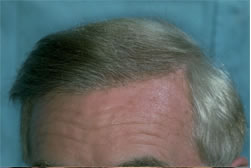- More about Hair Transplant Repair
Camouflage, the covering up of unsightly grafts with more natural looking ones, is the most basic of the hair transplant repair techniques. It can be used alone, or in conjunction with other methods of repair, such as graft excision. It can be used as a stand-alone technique if the grafts to be camouflaged are centrally located (i.e. not too close to the hairline), are not too large, and have hair pointing in the proper (forward) direction. If grafts need to be excised, it is best to perform camouflage as the final step (i.e. after all the problem grafts from the bad hair transplant have been removed and the hair from those grafts redistributed).
Although most grafts that need to be camouflaged were made using the old “plug” technique, almost all grafts that are larger than naturally-occurring follicular units (of 1-4 hairs) will need to be camouflaged to achieve the most natural hair restoration results. Besides plugs, grafts that cause cosmetic problems include: punch-grafts, slit grafts, and minigrafts. It is important to realize, however, that even very small grafts, if placed in the wrong location or at improper angles will look unnatural and must be corrected. It is important to note that camouflage alone can rarely correct grafts that are in the wrong location or pointing in the wrong direction. These grafts must invariably be removed.
Camouflage Procedures
In the past, camouflage had been performed using either small minigrafts or micro-grafts. With the development of Follicular Unit Transplantation (FUT) and Follicular Unit Extraction (FUE), all camouflage should now be performed using only naturally-occurring individual follicular units to achieve the best cosmetic results. When using follicular units for camouflage, single-hair units are placed at the front of the hairline, followed by 2- and, if appropriate, 3-hair units behind them. The 2- and 3-hair follicular units are placed both immediately in front of the larger grafts and between them to fill in any gaps that were created with the old technique. The extent of the correction will depend, to a large part, on the availability of adequate donor hair reserves.
Camouflage can be useful by itself if the abnormal grafts are far enough away from the hairline that a zone of follicular units can be placed in front of them (to mask their appearance) without having to bring the new hairline too far forward. In general, the larger the grafts, the deeper the zone of camouflage needs to be. This zone of camouflage can range anywhere from as little as a quarter of an inch to as much as 1½ inches, depending on how unsightly the old grafts are. If large grafts were placed close to the natural hairline, there may not be enough room to create this band of camouflage and the abnormal grafts would, therefore, need to be removed.
Examples of Camouflage Procedures
In this section, we will examine several Bernstein Medical patients who have had camouflage techniques incorporated into their repair procedures. View larger versions of the images in each patient’s profile in the Hair Transplant Repair gallery.
Example 1: Patient RPI
Patient RPI is an excellent example of using camouflage as the sole hair transplant repair technique. He had rows of plugs placed on the front part of his scalp by an aggressive hair restoration surgeon when he still had a lot of hair. Initially, the plugs were hidden by this existing hair. Over time, the hair around these plugs began to thin and the large grafts became more prominent. Because the two rows of plugs were situated away from the hairline, there was room to transplant a wide zone of follicular units in front of the plugs. The correction was achieved in just one FUT session. The hair for the camouflage procedure was obtained from the remaining donor supply in the back of his scalp.
Example 2: Patient ACS
Pluggy frontal hairlines are a common result of the punch-graft procedure. A soft zone of camouflage, using naturally occurring follicular units, was all that was needed to make Patient ACS’s original hair restoration appear more natural. Note how the very subtle “Widow’s peak” breaks up the linearity of the original bad hair transplant.
Example 3: Patient CFZ
The main cosmetic problem in Patient CFZ was not a pluggy hairline, but one that was too linear. This sharp demarcation had been created by a very regular row of minigrafts placed at his hairline. As in the previous patient, they were far enough above the patient’s natural hairline that camouflage alone was possible to accomplish the repair. An irregular zone of densely packed follicular units was placed in front of the more uniform row of mini-grafts making the original hair restoration look much more natural.
Example 4: Patient ZAO
Patient ZAO had a poorly executed hair transplant using mini-grafts of which not all survived the procedure. The poor growth of the minigrafts left gaps at the hairline and the ones that did grow looked tufted and unnatural. The hairline was corrected with a single session of follicular unit grafts.
Example 5: Patient BTI
Patient BTI had two hair restoration sessions in the early 1990s using large grafts. The procedures resulted in a pluggy, unnatural look. The correction that we begin in 1996, needed four camouflage procedures using a total of 4,768 follicular unit grafts. If performed today, graft excision would have been performed first, greatly reducing the number of grafts needed for the hair transplantation. Luckily, this patient had an abundant donor supply, but most repair patients are not so fortunate. Graft excision would have also allowed more flexibility in placing the hairline in a slightly higher, more natural position.
Example 6: Patient ABQ
In the old-plug technique, if the instrument (a punch) was not properly aligned with the follicles, the instrument would cut off the roots of the follicles and very little hair would actually grow. Patient ABQ had very little growth from his old transplant, and the procedure left skin that was scarred and depigmented with areas of dimpling (indentations in the skin from poorly situated hair-less grafts). In this case, camouflage was used to hide the scarred, damaged skin, rather than to cover up abnormal hair-bearing grafts.
For a comprehensive discussion of corrective procedures, read Dr. Bernstein’s paired publications, The Art of Repair in Surgical Hair Restoration: Part 1: Repair Strategies and Part 2: The Tactics of Repair.

